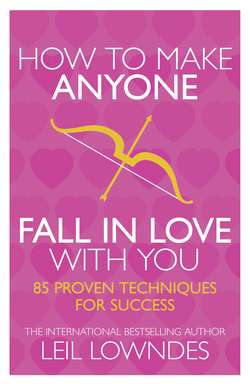Читать книгу How to Make Anyone Fall in Love With You: 85 Proven Techniques for Success - Leil Lowndes, Leil Lowndes - Страница 6
Science ‘Discovers’ Sex
ОглавлениеLong before Sigmund Freud tackled the subject, analytical scientific minds agreed that love was basic to the human experience. But their rational brains also deemed that evaluating, classifying and defining romantic love was impossible and therefore a waste of time and money. Freud went to his deathbed declaring, ‘We really know very little about love.’
His dying words remained the scientific doctrine. At least until the early 1970s when a pioneer-spirited band of social psychologists took up the scientists’ constant cries of ‘why?’ and ‘how?’ They began asking themselves – and everybody they could lure into their laboratories – questions about romantic love.
Two women psychologists made a breakthrough by inadvertently focusing the attention of the modern press on the ancient question of ‘What is love?’ Ellen Berscheid, PhD, with a colleague, Elaine Hatfield, managed to wangle an $84,000 federal grant to study romantic love. Berscheid convinced the National Science Foundation to open its coffers by declaring, ‘We already understand the mating habits of the stickleback fish. It is time to turn to a new species.’
Berscheid’s study, like others before, might have gone unnoticed and unpublished, except for a dozen or so pages in an obscure professional journal. Fortunately for love-seekers everywhere, one morning on Capitol Hill former United States Senator William Proxmire of Wisconsin was going through his papers. Buried deep in the pile was the NSF’S frivolous grant to two women to study relationships.
Proxmire hit the dome! Eighty-four thousand dollars to study what? He dashed off an explosive press release announcement that romantic love was not a science and, furthermore, he roared, ‘National Science Foundation, get out of the love racket. Leave that to Elizabeth Barrett Browning and Irving Berlin.’ Proxmire then added a personal note: ‘I’m also against it because I don’t want the answer.’ He assumed everyone felt the same. How wrong he was!
Proxmire’s reaction set off an international firestorm that raged around Berscheid for the next two years. ‘Extra! Extra! Read all about it. National Science Foundation Tackles Love!’ Newspapers had a field day. Cameras and microphones zeroed in on Berscheid with gusto. The quiet researcher’s office was swamped with mail.
Proxmire’s potshot at love had backfired. Instead of putting an end to the ‘frivolous pursuit’, his brouhaha generated tempestuous interest in the study of love. James Reston of the New York Times declared that if Berscheid et al could find ‘the answer to our pattern of romantic love, marriage, disillusion, divorce – and the children left behind – it would be the best investment of federal money since Jefferson made the Louisiana Purchase’.
It was as though Ellen Berscheid had pulled her finger out of the dyke. Ever since, there has been a torrent of studies scrutinizing every aspect of love. Respected social scientists with names like Foa, Murstein, Dion, Aron, Rubin and many others relatively unknown outside the scientific world have given us an as-yet-unopened gift – a gift we will unwrap now: the results of their labours, their studies, teach us (although that was not their purpose) how to make somebody fall in love.
Granted, some of the studies do not guide us directly to that goal. To find the relevant studies, I had to comb through hundreds of scientific probings with cumbersome titles such as ‘The Implications of Exchange Orientation on the Dyadic Functioning of Heterosexual Cohabitors’. (What?) Some studies had mice listening to classical music, then jazz and blues, to see which made them hornier.1 Other studies which were worthless to our goal explored sexual attraction to corpses,2 and then there were studies on tantric motionless intercourse,3 which, I assumed, works only when a couple’s honeymoon cruise ship hits rocky seas.
Happily, many studies bore tastier and more practical fruit. Especially helpful were studies by an intrepid researcher named Timothy Perper, a PhD student who spent many hours observing subjects in his favourite laboratory, called a ‘singles’ bar’. We also benefit from brilliant examinations by Robert Sternberg and his colleagues who explored theories of love. We learn from insightful early explorations into the elements of infatuation by Dorothy Tennov and others. There were courageous, if relatively unknown, researchers like Carol Ronai. She actually took a job as a table dancer in a topless bar to record what facial expressions turn men on.4
